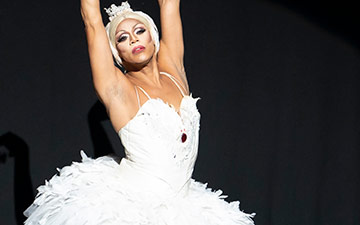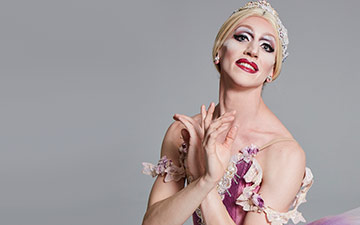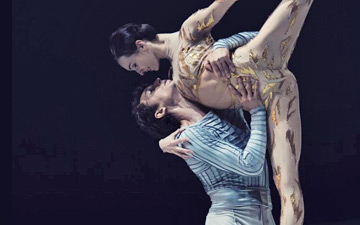
© Sascha Vaughan. (Click image for larger version)
Les Ballets Trockadero de Monte Carlo
Program A: Swan Lake (Act II), Black Swan Pas de Deux, The Dying Swan, Go For Barocco, Laurencia
Joyce Theater
18 December 2012
www.trockadero.org
www.joyce.org
Les Ballets Trockadero de Monte Carlo is a difficult company to write about, at least for this first-time viewer. Although the all-male ensemble performs in drag and on point to hilarious effect and adopts light-hearted stage names, it also dances serious works and at times displays serious artistry. Should one judge the Trocks first and foremost as a classical dancing company or as a comedy troupe?
I remain undecided, but it’s that ambiguity in their performances – the tension between seriousness and satire – that makes the company such a joy to watch. Although the Trocks danced five short works at different points of the seriousness-silliness spectrum on the opening night of their season at the Joyce Theater, the company fared best somewhere in the middle, when balancing both qualities.
Act II of Swan Lake, one of three works on the program to explore the quintessential ballerina-as-bird formula, showcased the Trocks’ acting chops and talent for physical comedy. Once the hunting party enters, the flock of swans abandons its graceful air and attacks Siegfriend’s attendant, Benno (Raffaele Morra as Pepe Dufka), kicking him as if in a street brawl. Later, a grand battement by one of the soloists topples a member of the corps standing to the side.
Yet amid the slapstick come moments of pure beauty, such as Odette’s (Robert Forleo as Marina Plezegetovstageskaya) impeccable supported pirouettes. The cygnets embody the duality perfectly: Their funny faces and flailing arms suggest confusion about the choreography while their feet rattle off crisp échappés.
Afterward, fittingly, came a version of “The Black Swan Pas de Deux” that, like the passage that preceded it, was mostly faithful to the Petipa choreography. The joke here had largely to do with stature: Odile (Chase Johnsey as Yakatarina Verbosovich) stood a full head above her Siegfried (Carlos Hopuy as Innokenti Smoktumuchsky). Verbosovich impressed with her stamina, particularly in the famous 32 fouettés (after which Von Rothbart presented her with an asthma inhaler), but much of her dancing looked strained, more athletic than elegant. Smoktumuchsky, who dazzled in his solo variation with his natural ballon, easily overshadowed her.

© Gene Schiavone. (Click image for larger version)
Best – and simplest – of all was Paul Ghislen’s The Dying Swan, a parody of the famous solo choreographed by Michel Fokine for Anna Pavlova. A confused spotlight darts back and forth, finally landing on Ghislen’s Ida Nevasayneva as she tiptoes onstage, molting clumps of feathers by the second. She loses herself in mournful port de bras, only to comically flap her legs seconds later. The laughs are well deserved, but the solo’s humor doesn’t erase its underlying tone of tragedy. When Nevasayneva struggles in vain to stuff feathers back into her tutu, it’s somehow both funny and heartbreaking.
The target of parody then switched from dancer to choreographer with Go For Barocco, Peter Anastos’s witty sendup of George Balanchine’s 1942 neoclassical masterpiece, Concerto Barocco (which happens to be my favorite ballet). A number of Balanchine’s steps are pushed to hilarious extremes: the daisy chains whip the dancers unceremoniously and wind up in knots; the subtle rivalry between the two female principals, expressed through eclipsing kicks and dramatic shifts in épaulement, becomes an all-out catfight.
Elsewhere, however, Go For Barocco references other celebrated works in the Balanchine canon, most obviously Apollo. In the second movement, Larissa Dumbchenko (Raffaele Morra) and Sonia Leftkova (Boysie Dikobe) fight literally for the upper hand, frantically placing their fists on top of each other’s, like the tower Balanchine’s Apollo and Terpsichore build with their arms. The power walking in Go For Barocco’s first and third movements recalls how Balanchine’s hero and muses shuffle about on their heels.
The evening’s finale, Laurencia (2004, after Vakhtang Chabukiani), was the only disappointment. A program note claims that the original ballet, about a peasant uprising in a small Spanish town, was a smash hit in the Soviet Union after its 1939 premiere, but it was difficult at this performance to see why.
The choreography abounds with Don Quixote clichés – dramatic jétés, neck tilts, fan flips, and bullfighting-inspired steps – but they’re assembled with little originality or effect. As the female lead, Robert Carter (as Olga Supphozova) approached bravura steps with hesitation; I wondered several times whether he might have been injured.
Laurencia, a new addition to the repertory, was the one work on the program that the Trocks performed without a hint of parody, apart from the customary heavy makeup. Earlier, the Trocks had proved their skill with both art and comedy. Why choose a ballet without either?

















You must be logged in to post a comment.